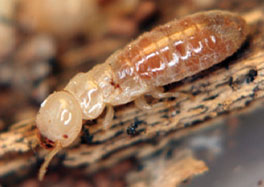
Dampwood termites infest wood with high moisture content, creating tunnels while eating across the grain of the wood. Wood in contact with the ground or with high moisture content is vulnerable to attack. Logs, stumps, dead trees, leaky pipes, or gutters can provide favorable conditions for correcting these conditions conducive to infestation.

Drywood Termites construct a virtual city within the wood. They carve out galleries in wood beams and use tunnels to move from place to place. Drywood termites swarm annually to start new colonies. Attic and eave areas are prime targets for swarmers in search of a nesting location, as are windowsills, baseboards, beams and door frames. A swarmer can enter a structure by penetrating the smallest crack or imperfection in the wood. Drywoods can also be introduced into the environment in infested furniture or construction materials.

Formosan Termite, a species of subterranean termite, is one of the most aggressive and destructive termites in the world. Often referred to as the “Super Termite,” Formosans cause extensive structural damage to your home by eating through wood at rapid rates. A Formosan colony can contain as many as eight million members and span 3,000 feet. These termites generally live underground, tunneling through the soil in search of food. To avoid exposure to light, Formosans may create mud tunnels above the surface.

Subterranean Termite Left undetected, this termite tirelessly attacks your home 24/7, causing dangerous and costly structural damage. Subterranean termites tunnel their way through wooden members, such as timbers in the structure of a house, as they search for and consume cellulose, the material found in the plant cells of wood. They are most likely to attack from beneath the structure, gaining access through the smallest cracks and imperfections in the foundation. As a rule, subterranean termites travel above ground for food (cellulose) and underground for moisture. A termite mud tunnel found between the soil and wood construction of your home is a sign of infestation.